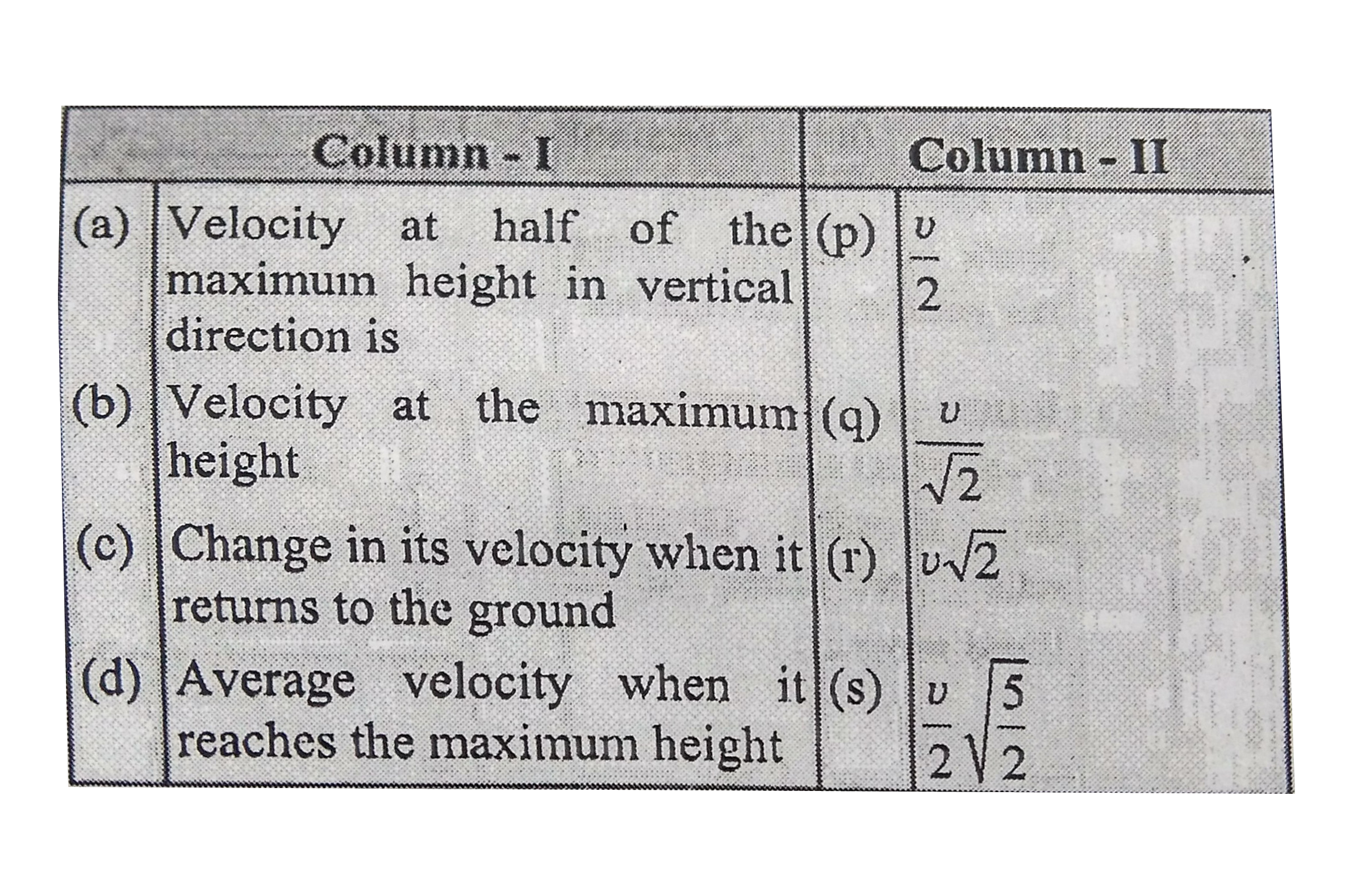A ball is projected from the ground with velocity v such that its range is maximum. Match the columns.
COLUMN-I
(A) Velocity at half of the maximum height
(B) Velocity at the maximum height
(C) Change in its velocity when it returns to the ground
(D) Average velocity when it reaches the maximum height.
COLUMN-II
(P) √3v2
(Q) v√2
(R) v√2
(S) v2√52
The correct Answer is:A, B, C, D
To solve the problem, we need to match the items in COLUMN-I with those in COLUMN-II based on the physics of projectile motion. Let's break down the solution step by step.
Step 1: Understanding the Conditions for Maximum Range
The maximum range of a projectile occurs when it is launched at an angle of 45∘. For a projectile launched with an initial velocity v:
- The range R is given by:
R=v2sin(2θ)g
At θ=45∘, sin(90∘)=1, so:
R=v2g
- The maximum height H is given by:
H=v2sin2(θ)2g
At θ=45∘, sin2(45∘)=12, so:
H=v24g
Step 2: Finding the Velocity at Half of the Maximum Height
At half of the maximum height (H/2=v28g), we can use the conservation of mechanical energy. The total mechanical energy at launch is:
Einitial=12mv2
At height H/2:
Efinal=12mv′2+mg(v28g)
Setting these equal gives:
12mv2=12mv′2+mv28
Solving for v′:
12mv2−mv28=12mv′2
4mv28−mv28=12mv′2
3mv28=12mv′2
v′2=3v24⇒v′=√32v
Thus, (A) matches with (P): √3v2.
Step 3: Finding the Velocity at Maximum Height
At maximum height, the vertical component of the velocity is zero, and only the horizontal component remains:
vhorizontal=vcos(45∘)=v√2
Thus, (B) matches with (Q): v√2.
Step 4: Change in Velocity When Returning to the Ground
The velocity vector at launch is:
→v1=(v√2,v√2)
At the ground level when it returns:
→v2=(v√2,−v√2)
The change in velocity Δ→v=→v2−→v1:
Δ→v=(0,−v√2−v√2)=(0,−√2v)
The magnitude of the change in velocity is:
|Δ→v|=√02+(−√2v)2=√2v
Thus, (C) matches with (R): v√2.
Step 5: Average Velocity When Reaching Maximum Height
The average velocity Vavg is given by:
Vavg=Total DisplacementTime
The displacement to the maximum height is:
Displacement=(R2,H)=(v2/g2,v24g)
The time to reach maximum height is:
t=vsin(45∘)g=v/√2g
Thus,
Vavg=(v22g,v24g)v√2g=(v22g⋅√2v,v24g⋅√2v)=(v√22,v√24)
Calculating the average velocity gives:
Vavg=v√22 (in terms of magnitude)
This matches with (D) and (S): v2√5/2.
Final Matches:
- (A) - (P): √3v2
- (B) - (Q): v√2
- (C) - (R): v√2
- (D) - (S): v2√5/2
The maximum range of a projectile occurs when it is launched at an angle of 45∘. For a projectile launched with an initial velocity v:
- The range R is given by:
R=v2sin(2θ)g
At θ=45∘, sin(90∘)=1, so:
R=v2g
- The maximum height H is given by:
H=v2sin2(θ)2g
At θ=45∘, sin2(45∘)=12, so:
H=v24g
At half of the maximum height (H/2=v28g), we can use the conservation of mechanical energy. The total mechanical energy at launch is:
Einitial=12mv2
At height H/2:
Efinal=12mv′2+mg(v28g)
Setting these equal gives:
12mv2=12mv′2+mv28
Solving for v′:
12mv2−mv28=12mv′2
4mv28−mv28=12mv′2
3mv28=12mv′2
v′2=3v24⇒v′=√32v
Thus, (A) matches with (P): √3v2.
At maximum height, the vertical component of the velocity is zero, and only the horizontal component remains:
vhorizontal=vcos(45∘)=v√2
Thus, (B) matches with (Q): v√2.
The velocity vector at launch is:
→v1=(v√2,v√2)
At the ground level when it returns:
→v2=(v√2,−v√2)
The change in velocity Δ→v=→v2−→v1:
Δ→v=(0,−v√2−v√2)=(0,−√2v)
The magnitude of the change in velocity is:
|Δ→v|=√02+(−√2v)2=√2v
Thus, (C) matches with (R): v√2.
The average velocity Vavg is given by:
Vavg=Total DisplacementTime
The displacement to the maximum height is:
Displacement=(R2,H)=(v2/g2,v24g)
The time to reach maximum height is:
t=vsin(45∘)g=v/√2g
Thus,
Vavg=(v22g,v24g)v√2g=(v22g⋅√2v,v24g⋅√2v)=(v√22,v√24)
Calculating the average velocity gives:
Vavg=v√22 (in terms of magnitude)
This matches with (D) and (S): v2√5/2.
- (A) - (P): √3v2
- (B) - (Q): v√2
- (C) - (R): v√2
- (D) - (S): v2√5/2
Similar Questions
Knowledge Check
- Question 1 - Select One
A ball is projected from the ground with velocity u such that its range is maximum Then
AIts velocity at half the maximum height is √32uBIts velocity at the maximum height is uCChange in its velocity when it returns to the ground is uDall the above are true - Question 2 - Select One
A particle is thrown vertically upwards. If its velocity is half of the maximum height is 20m/s, then maximum height attained by it is
A25 mB30 mC35 mD40 m - Question 3 - Select One
The velocity at the maximum height of a projectile is half of its velocity of projection u. Its range on the horizontal plane is
A3u2gB√3u22gC3u2g2Du23g
A stone is thown vertically upwards with a velocity of 4.9ms−1. Calculate (i) the maximum height reached (ii) the time taken to reach the maximum height (iii) the velocity with which it returns to the ground and (iv) the time taken to reach the ground.
View SolutionA body is projected vertically up with a valocity u. its velocity at ghalf of its maximum height and at 3/4th of its maximum height are.
View SolutionA body is projected obliquely from the ground such that its horizontal range is maximum.If the change in its maximum height to maximum height, is P, the change in its linear momentum as it travels from the point of projection to the landing point on the ground will be
View SolutionA body is projected obliquely from the ground such that its horizontal range is maximum. If the change in its linear momentum, as it moves from half the maximum height to maximum height, is P, the change in its linear momentum as it travels from the point of projection to the landing point on the ground will be:
View SolutionA projectile is thrown with velocity v at an angle θ with the horizontal. When the projectile is at a height equal to half of the maximum height,.
The velocity of the projectile when it is at a height equal to half of the maximum height is.View Solution


